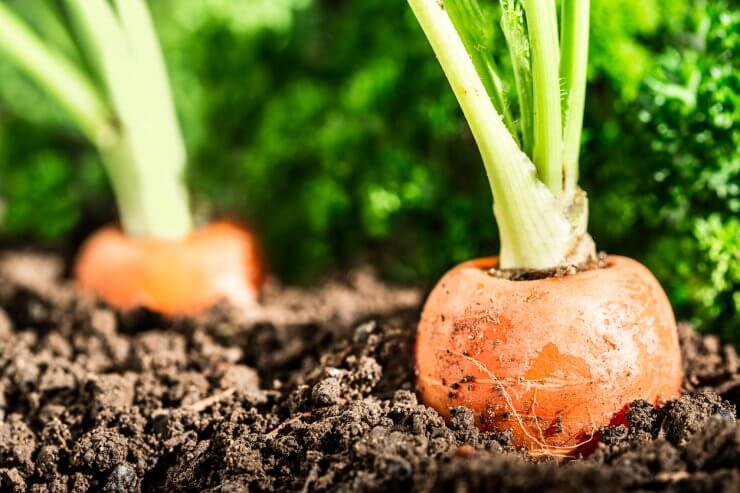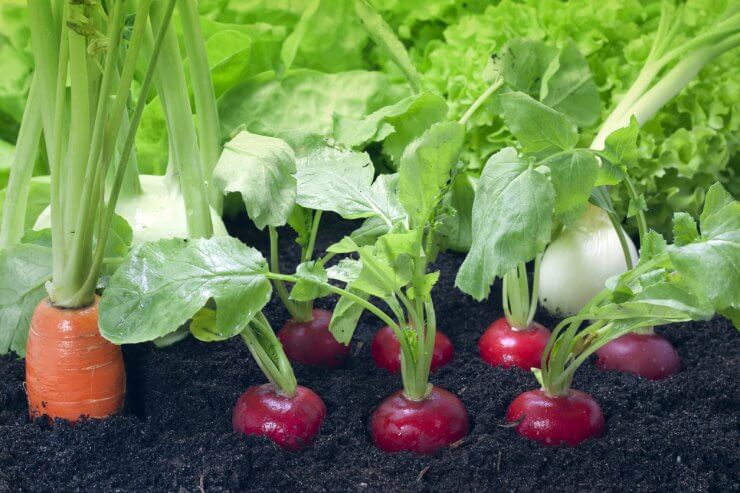
Carrots growing in the ground
Carrots need lots of sunshine in order to thrive—six to eight hours of sunshine a day. They’ll tolerate partial shade, but find them the sunniest spot you can. They also need well-drained soil with a pH of 6.0 to 7.0. They don’t need a lot of fertilizer to get going. The most important thing is that the soil is rich, loose, and free of obstructions—otherwise you’ll get those weird carrots with extra legs.
Planting
Planting carrots is easy: after you’ve made sure your soil is loose and free of obstacles, dig a furrow about a half inch deep and water it lightly. Plant your seeds about an inch-and-a-half apart in rows 12 to 18 inches apart, depending on the variety. It’s better to plant your seeds intentionally rather that broadcasting them; you’ll save yourself thinning time once the plants get going.
If you want to make it easier to see where the tiny seeds are going, you can mix your seeds with some sand just for the contrast, to help you keep track of where you’ve already seeded. You could also use a little seed sower, a funnel, or a widger to help you guide your seeds to the right spot.
Cover your seeds with the soil you moved aside to make the furrow. If the top of the soil is dry, mist it lightly. Remember, carrot seeds are tiny. You don’t want to wash them away.
Carrot seeds take almost two weeks to germinate. In that time, one heavy rain is all it will take to wash your seeds away. Some gardeners put down a plank of untreated wood on top of their seed rows to protect the seeds from excess water. It also helps retain moisture. A row cover serves the same purpose; just make sure all the edges are weighted down to the ground. Remove the covers between five and 10 days after planting to check on the germination process and (hopefully) give your sprouts the sunlight they need to start growing.
Succession Planting
If you’d like to have a continuous carrot crop, try succession planting: plant a new row of seeds every two or three weeks so you never run out of carrots. Try planting a different variety each time. It’s a great way to sample new varieties of carrots.
Planting Timing
Remember, since carrots are a cool weather crop, you have two opportunities to grow them. You can plant them in late spring for a summer crop, and again in late summer (if it’s cool enough) for a fall crop before your region’s hard frost date. It’s probably a good idea to choose an early variety if you live in a frost-prone area.
Plant Spacing
Once your seedlings get growing, you’ll want to thin them to about 3 to 4 inches apart, depending on the variety you’re growing. Be sure to check the seed packet (always save your seed packets!) for specific guidelines for the variety you’re growing.
In general, rows should be between a foot and a foot-and-a-half apart. If you’re doing succession planting (planting new seeds every few weeks), plan your garden space accordingly.
Companion Planting

Carrots growing alongside other vegetables in the garden
Companion planting can serve several purposes. You can choose plants to help repel pests to protect your main crop; you can plant something like nasturtiums to attract aphids so they don’t attack your carrots, and you can plant companion plants to help you remember where you planted your carrots.
Because carrot seeds are so small and they have such a long germination time, you can plant radishes along with your carrots, if only to help you mark the rows. Of course, you could also use row markers—but you can eat the radishes!
If you want to do some companion planting (sometimes called interplanting), choose plants with shallow root systems so the two plants aren’t fighting for resources. Good companion plants for carrots include:
- chives
- onions
- leeks
- tomatoes
- rosemary
- coriander
- lettuce
- radish
Leeks and onions are a really good choice since their scent confuses and repels the dreaded carrot rust fly; plus, they’re delicious. You can see all our companion planting suggestions in our Companion Planting Chart. Print it out and keep it handy when you’re planning your garden.
How do you plant your carrots? What criteria for site selection have worked for you? Do you use your carrots as companion plants? Please share your ideas with us.


 Previous
Previous


I have yet to grow slender straight carrots. The soil is loose from years of composting , but they grow deformed , very artsy . I would prefer straight cylindrical carrots
I need advice to succeed this year .